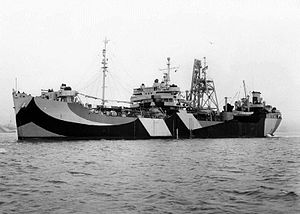 USS Pasig (AW-3) in 1945.
| |
| History | |
|---|---|
| Name | USS Pasig |
| Namesake | Pasig River in the Philippines |
| Builder | Marinship Corporation, Sausalito, California |
| Laid down | 18 May 1944 |
| Launched | 15 July 1944 |
| Commissioned | 11 December 1944 |
| Decommissioned | February 1947 |
| Recommissioned | 15 March 1951 |
| Decommissioned | 15 June 1955 |
| Stricken | 1 July 1960 |
| Honors and awards | 6 battle stars (Korea) |
| Fate | Sold for scrapping 16 October 1975. |
| General characteristics | |
| Type | Pasig-class distilling ship |
| Displacement |
|
| Length | 523 ft 6 in (159.56 m) |
| Beam | 68 ft (21 m) |
| Draft | 30 ft 10 in (9.40 m) |
| Installed power | 3,000 shp (2,237 kW) |
| Propulsion | Turbo-electric drive, single propeller |
| Speed | 14 knots (26 km/h; 16 mph) |
| Complement | 265 officers and enlisted |
| Armament |
|
USS Pasig (AW-3) was one of four water distilling ships built for the United States Navy during World War II. The lead ship in her class, she was named for the Pasig River (the second U.S. Naval vessel to bear the name) which flows through Manila on the Island of Luzon, Philippines.
Originally laid down as SS Mission San Xavier, a Maritime Commission T2-SE-A2 tanker (MC hull 1826) by the Marinship Corporation of Sausalito, California on 18 May 1944; renamed USS Pasig (AO–91) on 3 July 1944; launched on 15 July 1944, sponsored by Mrs. John A. McCone; redesignated USS Pasig (AW–3) on 28 August 1944; acquired by the Navy from the Maritime Commission on 21 October 1944; and commissioned on 11 December 1944.